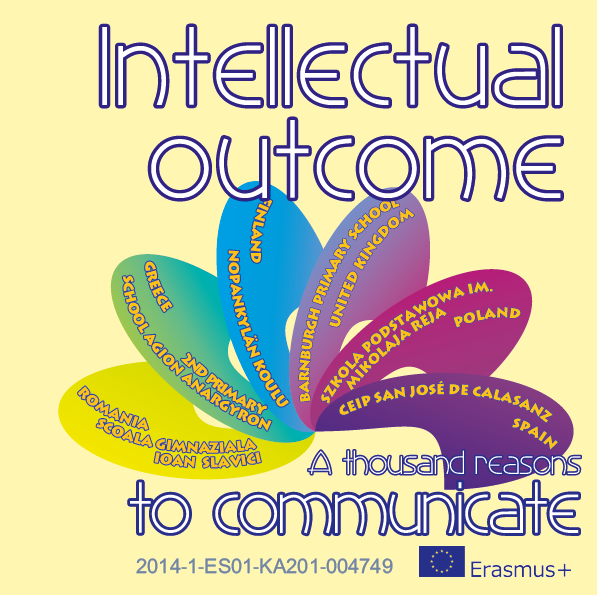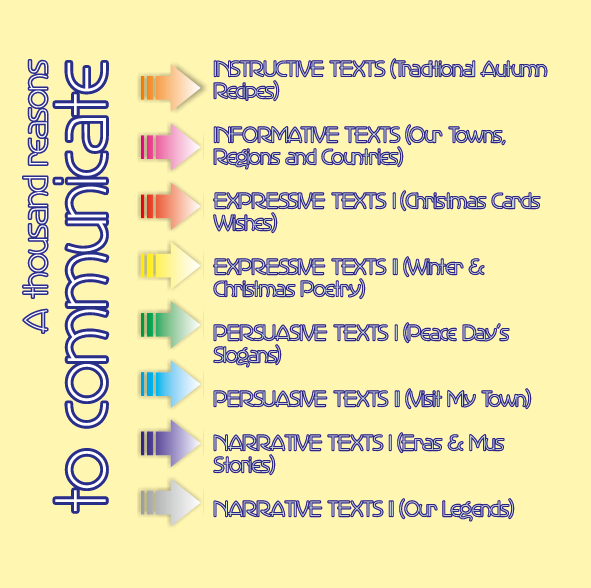 |
 |
Everything started with an idea in mind; how to help our students improve their communicative skills in both mother tongues and in foreign languages. There was a need to create contexts for them to listen, read, write and speak. But, do children use language only in stories? Surely not! However, sometimes we forget that teaching infants and primary students does not imply “living in fairy tale”. We worked in depth through tales and stories in our last Comenius. But we wanted to go further this time. That is why we wanted to expose them to other situations in order to help them communicate in a wide variety of contexts. We wanted to provide our students with enough tools to help them grown asmembers of our society.
We also agreed on the need to improve the quality of our teaching. That is why we wanted to explore new methodologies and become more conscious of the educative improvements this project would bring us. Besides, we wanted to help our students in the use of the ICT as we, teachers, sometimes forget that students are the ones who should be active participants in developing their digital skills.
All together gave us the idea that our students are all surrounded by tons of linguistic contexts, written or digital, and we wanted to guide them through the process of stepping into the real world. We came up with the idea that there are “A thousand Reasons to Communicate”, so we could worked with different text types as each one of them responds to a communicative situation and intention.
Moreover, we wanted something that went deeper and stayed for a long time in our schools. That is why we thought that we could create a long lasting product that would remain in our schools and that we could show to others. That was the beginning of the idea; to creat a resource for teachers that would include the didactic units we developed in the two years of the association.
So here, we are presenting our intellectual outcome, a compilation of didactic units developed by a group of enthusiastic and hardworking teachers from six European schools. This intellectual outcome is divided into the different text types used in our two years project. All the schools worked and pace the activities to follow and fulfill the agreements established at the beginning. We all used Etwinning to publish what our students had created. So the intellectual outcome is a compilation of units written by teachers full of examples done by our students.
We had the chance to present our intellectual outcome to other teachers and educative authorities in the “Multiplier Event” we organized during our last meeting in Fraga (Spain). We presented this educative resource in Huesca on the 10th of May 2016, in the Teachers Center (CIFE Huesca). All participants in this meeting received information about the worked we had done during the two years and received a digital published copy of our intellectual outcome. Apart from this, each one of our schools agreed on explaining and transmitting all the information to our educative agencies, colleagues and our reference teachers’ centers.
Our only wish after these two years working together is the hope that tis intellectual outcome can be a useful resource to everyone.
Introduction
 |
 |
 |
 |
 |
| Introduction |
INSTRUCTIVE TEXTS
(Traditional Autumn
Recipes) |
INFORMATIVE TEXTS
(Our Towns,
Regions and Countries) |
EXPRESSIVE TEXTS
(Christmas ards Wishes)
|
EXPRESSIVE TEXTS
(Winter &
Christmas Poetry) |
| |
 |
 |
 |
 |
| |
PERSUASIVE TEXTS
(Peace Day's Slogans) |
PERSUASIVE TEXTS
(Visit My Town) |
NARRATIVE
TEXTS
(Eras & Mus Stories) |
NARRATIVE TEXTS
(Our Legends) |